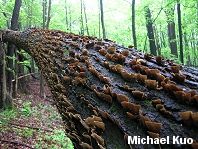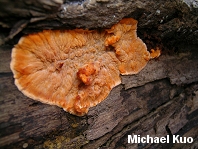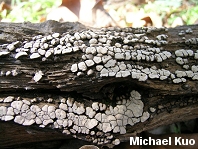| Major Groups > Crust Fungi |

|
Crust Fungi by Michael Kuo I'm using the unscientific term "crust fungi" to refer to various wood-decomposing mushrooms that have a smooth to pimpled or wrinkled spore-bearing surface; they lack the pores that typify polypores, or the teeth that typify the toothed mushrooms. One good way to see the difference is to compare two classic and common wood rotters: the polypore Trametes versicolor and the crust fungus Stereum ostrea (sometimes called the "Turkey Tail" and the "False Turkey Tail," respectively). From above these mushrooms look very similar, but when turned over the polypore has very tiny pores, while the crust fungus has a smooth undersurface. My treatment of crust fungi is unfortunately cursory (for the time being, at least), and centered around the larger, fruiting-body-developing species; there are multitudes of resupinate crusts that require painstaking microscopic analysis for accurate identification, and my interests tend to be more "mushroom" oriented. But I find the crusts interesting, and hope to give them, some day, the attention they deserve. Aleurodiscus oakesii |
|
|
References Beug, M. W., A. E. Bessette & A. R. Bessette (2014). Ascomycete fungi of North America: a mushroom reference guide. Austin: University of Texas Press. 488 pp. Burdsall, H. H. (1985). A contribution to the taxonomy of the genus Phanerochaete (Corticiaceae, Aphyllophorales). Mycologia Memoir No. 10. Braunschweig, Germany: J. Cramer. 165 pp. Chamuris, G. P. (1985a). On distinguishing Stereum gausapatum from the "S. hirsutum-complex." Mycotaxon 22: 1–12. Chamuris, G. P. (1985b). Infrageneric taxa in Stereum, and keys to North American species. Mycotaxon 22: 105–117. Chamuris, G. P. (1988). The non-stipitate stereoid fungi in the northeastern United States and adjacent Canada. Berlin: J. Cramer. 247 pp. Coker, W. C. (1921). Notes on the Thelephoraceae of North Carolina. Journal of the Elisha Mitchell Scientific Society 36: 146–196. Cooke, W. B. (1956). The genus Phlebia. Mycologia 48: 386–405. Corner, E. J. H. (1968). A monograph of Thelephora (Basidiomycetes). Verlag: J. Cramer. 116 pp. Eriksson, J. & L. Ryvarden (1973). The Corticiaceae of North Europe. Volume 2: Aleurodiscus–Confertobasidium. Oslo, Norway: Fungiflora. 231 pp. Ezhov, O. N., I. V. Zmitrovich & R. V. Ershov (2012). New records of wood-rotting Basidiomycetes in the boreal forests of the eastern European north, Arkhangelsk Region, Russia. Agriculture and Forestry 58: 39–50. Floudas, D. & D. S. Hibbett (2015). Revisiting the taxonomy of Phanerochaete (Polyporales, Basidiomycota) using a four gene dataset and extensive ITS sampling. Fungal Biology 119: 679–719. Ginns, J. H. (1975). Merulius: s.s. and s.l., taxonomic disposition and identification of species. Canadian Journal of Botany 54: 100–167. Ju, Y. -M. & J. D. Rogers (2001). New and interesting Biscogniauxia taxa, with a key to the world species. Mycological Research 105: 1123-1133. Lemke, P. A. (1964). The genus Aleurodiscus (sensu stricto) in North America. Canadian Journal of Botany 42: 213–282. Miettinen, O., V. Spirin, J. Vlasak, B. Rivoire, S. Stenroos & D. S. Hibbett (2016). Polypores and genus concepts in Phanerochaetaceae (Polyporales, Basidiomycota). MycoKeys 17: 1–46. Nakasone, K. K. & H. H. Burdsall, Jr. (1984). Merulius, a synonym of Phlebia. Mycotaxon 21: 241–246. Rogers, J. D. & Y. -M. Ju (1998). The genus Kretzschmaria. Mycotaxon 68: 345–393. Rogers, J. D., A.N. Miller & L. N. Vasilyeva (2008). Pyrenomycetes of the Great Smoky Mountains National Park. VI. Kretzchmaria, Nemania, Rosellinia and Xylaria (Xylariaceae). Fungal Diversity 29: 107–116. Stalpers, J. A. (1993). The aphyllophoraceous fungi I. Keys to the species of the Thelephorales. Studies in Mycology 35: 1–168. Welden, A. J. (1971). An essay on Stereum. Mycologia 63: 790–799. This site contains no information about the edibility or toxicity of mushrooms. Cite this page as: Kuo, M. (2008, December). Crust fungi. Retrieved from the MushroomExpert.Com Web site: http://www.mushroomexpert.com/crusts.html © MushroomExpert.Com |


